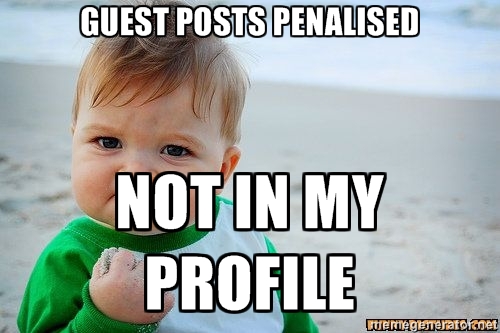How To Massively Scale Ethical Link Building FTW
The linkbuilding toolkit is broader than most commentary suggests, and once the concept of quality and appropriateness (AKA relevancy) is truly embraced (and not just paid lip service to), then the dynamic, cutting edge solution to linkbuilding in 2014 is obvious: scale your processes that generate high quality targets and content opportunities for linkbuilding across the spectrum of all types of linkbuilding.
Working on the big brand, white-hat side of SEO for the last decade or so, I’ve seen plenty of flash-in-the-pan link building strategies come and go on the other side of the fence: content spinning, blog rings, mass directory submissions, forum spamming, domain acquisition, microsite spam & redirection, 302 hijacking, widget command and control anchors, plain vanilla paid links, etcetera, etcetera…
 There have been plenty of so-called “Grey Hat” strategies, too: paid links disguised as affiliate schemes, spurious sponsorship or badge schemes, reward-led blog linking, Google Base mislisting and Google Local hijacking to name just a few.
There have been plenty of so-called “Grey Hat” strategies, too: paid links disguised as affiliate schemes, spurious sponsorship or badge schemes, reward-led blog linking, Google Base mislisting and Google Local hijacking to name just a few.
I’ve also seen the line of ethics shifted underfoot by search engines (typically Google, of course) — over-optimisation, the rise and fall of nofollow sculpting, the death of articles — and the struggle of over-reliant agencies to adapt.
Google’s recently changed tolerance to guest post blogging is just the latest in a long line of tweaks that usually trigger cries of SEO’s “death” from newcomers and resigned shrugs of indifference from older hands in the industry.
The reason for this indifference amongst veterans is a knowledge that link building is not so black and white — that quality ultimately underpins the value of a particular type of link building. Easy to say, of course, but is it quantifiable?
Would you be surprised to hear that, in a recent new client backlink strategy audit, a directory submission came out as highest priority? That directory was the UK government’s National Health Service (NHS) — high value, free, accredited and subject to proper vetting for inclusion. In short, the site is a high-quality resource that also drives genuine, relevant traffic.

Success Kid has a diversified backlink profile.
I’m not suggesting that directory submissions are a dynamic, industry-leading tool that will transform your link building strategy. They won’t.
What I am suggesting is that the link building toolkit is broader than most commentary suggests — and once the concept of quality and appropriateness (AKA relevancy) is truly embraced (and not just paid lip service to), then the dynamic, cutting edge solution to link building in 2014 is obvious: scale your processes that generate high quality targets and content opportunities for link building across the spectrum of all types of link building.
As it happens, we’ve done that at QueryClick already. (What are the chances, eh?)
Scale Process, Build Your Toolkit
The key to effective link building is diversity — diversity of domains in the overall link profile, but also diversity in process, in the tools used. Directories are one kind of tool, and they can be easily misused. Guest posts are another.
Let’s look at the first part of our scale: domain diversity. How do we repeatedly revisit processes and throw up new domains each time without eroding the value in the pool of domains? (In other words, how do we avoid creating a race to the bottom of the barrel, producing less and less valuable domains each time we revisit a process?)
Simple: we devise a process that can refocus on different targets easily. What does that look like for link building? Segmentation.
Segmenting Process
I’ve written before about a process that allows you to take classical marketing’s competitor SWAT analysis approach and apply it to generating link building ideas. At the outset of this analysis, we use segmented keyphrase sets. The best way to envisage this is to take an example:
Let’s say you are in a competitive niche, like online dating. Let’s also assume that you are a big brand that is looking to perform globally. What segments are available to you?
You can segment by location, picking out the biggest target cities in your main target countries, and construct keyphrase sets using “dating” related terms.
You can segment by language where target countries have multiple communities with different principle search languages.
You can segment by gender, by sexual preference, by dating type (speed, meetups), by age group (or other demographic segment), by class or job, or… you get the idea.
For each of these sets — and we can easily generate meaningful sets of search terms around any of the above examples, multiplied by each target country — we can assess which the top performing domains are right now in our search engine of choice. You can use any ranking tool and value assessment methodology that works for you here. That gives you top performing domains for each segment, the starting point for our backlink SWAT analysis.
Top Performing Domains
Now, the cynical (or most rational!) among you might be thinking that despite all this segmentation, we’ll see the same domains returning top again and again for each set. Well, the insider tip I’ll reveal today is this: you’d be dead wrong.
As soon as you look at well-segmented keyphrase sets at scale, you start to glimpse the enormity of the internet. There are niches within niches within niches, each more relevant than the last, each with years of brand building and online effort behind them, each as well known to their niche as Walmart is to you and me (or, indeed, as Search Engine Land is to you and me).
Here is your scale.
Get The Biggest Bang For Your Buck
Now that we have a fund of fantastic performing domains, we need to prioritise and parcel out the
work to build those lovely, diverse links back to our (or our client’s) site.
At this stage, we are back in common SEO ground: content is key.
What we have, in addition to lists of valuable domains already linking to an infinite array of micro-competitors, is a diverse type of domain. Unique directories, niche blogs, local authority domains, oddball communities and social groups, mailing lists, university clubs, weekend activity forums, global brands, events, resources, local newspapers, radio, podcasts, magazines, listing sites, wikis, affiliated businesses, hobbyists….
Everyone can be engaged with different types of content. This isn’t a content issue, this is a rolling marketing program which not only builds valuable links (thanks to our science at the start of this process), but also drives traffic, raises brand awareness and informs other (offline and online) marketing efforts and strategies.
And the best bit? Not once have you done anything against webmaster guidelines; in fact, you’re doubling down on their stance. You’re protecting your strategy, you’re building sustainable links that are there for the long term. You’re making sure you’re not going to be hit by a devaluing or penalization of previously acceptable tactics (a la guest blogging), and you’re building brand equity all at the same time.
This means that next time there’s a clamp down on black-hat link building, you’ll be there with the old hands, reaping the rewards.
Images via Shutterstock, used with permission.
Contributing authors are invited to create content for Search Engine Land and are chosen for their expertise and contribution to the search community. Our contributors work under the oversight of the editorial staff and contributions are checked for quality and relevance to our readers. The opinions they express are their own.
Related stories


